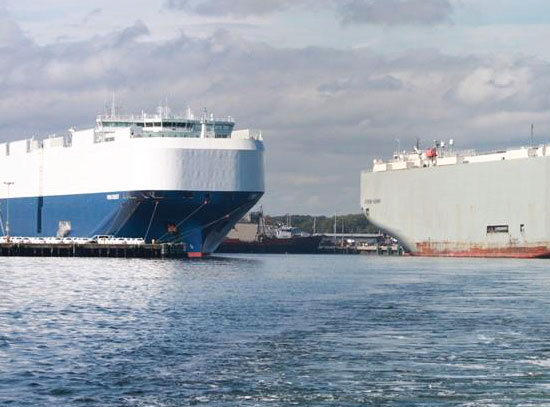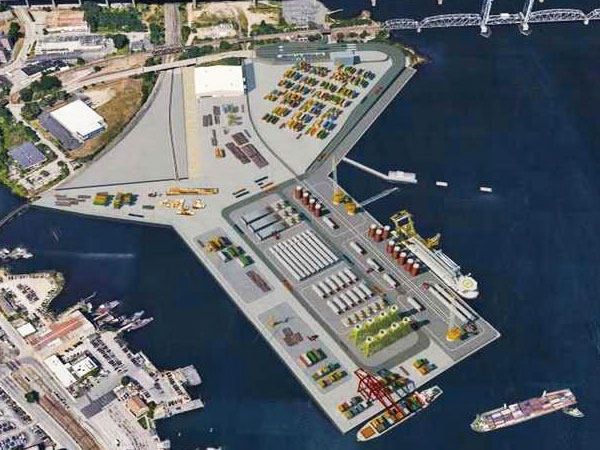The Port of Davisville is one of the most successful, but under-reported ports in the U.S.
In 2018, the port set another ho hum record importing 280,387 automobiles in an increase of 8.7% from 2017, which had previously set the record for most autos imported. Of course, that’s nothing new as it seems to set records every year or at least seven out of the last eight to be exact.

Last year, the Quonset Development Corporation (QDC), which manages the port and the surrounding 3,200-acre Quonset Business Park, invested $56 million in infrastructure projects throughout the park in 2018. The upgrades included new gateway office buildings, renovations to Pier 2 at the port and the development of the new flex industrial campus. There was also another $340 million in private investment by Quonset companies for 655,180 sq./ft. of new building construction. The port has four berths and more than 60 acres of storage area, which has served the port well for project work such as wind power parts.
By any measure, the port is moving in the right direction. Of the record 280,387 vehicles handled, 241,851 arrived by ship, with the others being delivered by rail or truck. The tally put the small Rhode Island port in the Top 10 for auto imports in North America – no mean feat with competition including heavy weights like Baltimore, New York/New Jersey, Long Beach and Los Angeles.
There also may be new business on the horizon. The Port of Davisville was chosen to join a new maritime highway initiative and awarded an $855,200 federal grant in August 2018 to facilitate the purchase of new shipyard equipment. The updated equipment will ease cargo-handling operations and support the Port’s new role in the marine highway initiative.
The new barge service will run between Brooklyn, NY, Newark, NJ and the Port of Davisville in Rhode Island. The service will include a dedicated run twice a week utilizing one 800-TEU capacity deck barge and will remove approximately 83,200 containers and 14,976,000 vehicular miles annually from the road. It will also relieve landside congestion and lower transportation costs for shippers while providing additional economic opportunities regionally.
CPA Maritime Strategy Underway
There is a lot going on in Connecticut ports as the State has hit the reset button for launching a revamping of the maritime industries in the State.
In a manner, it began in 2018 when the Connecticut Port Authority (CPA) adopted the Connecticut Maritime Strategy to serve as a roadmap for CPA’s investment decisions and resource allocations over the next five years. The strategy sets out eight key goals as the CPA leads the mission to expand Connecticut’s maritime economy and create jobs through strategic investment in the state’s three deepwater ports and small harbors.

This strategy was put into motion with the choosing of a terminal operator for the Port of New London. On January 30th, the CPA announced it had reached an agreement with Gateway New London LLC for the long-term operation of State Pier in New London.
Evan Matthews, executive director of the CPA, said of the agreement, “After months of effort on behalf of the CPA staff and Board, we are pleased to partner with Gateway on the continued development and expansion of State Pier …The CPA and Gateway have undertaken an extensive process to maximize outcomes and potential, and we see this partnership as the next step towards fulfilling a key objective of our 2018 Maritime Strategy.”
Under terms of the 20-year agreement, Gateway assumes operation of State Pier on May 1, 2019, with an option at the end of the term for the CPA to extend for two additional ten-year periods. The new contract requires that an annual fixed fee of $500,000 be paid to the CPA, increasing by $250,000 every five years. The CPA will also receive a variable fee of 7% of Gateway’s gross revenues at State Pier, with a minimum annual guarantee of $500,000 that has the potential to increase every five years based on Gateway’s percentage increase in gross revenues. Finally, Gateway will pay an annual wharfage and dockage fee equal to 50% of all wharfage and dockage user fees at State Pier. All together, these terms will provide CPA with a substantial increase in revenue versus the current operations.
Offshore Wind Projects
One of the main purposes of the Gateway agreement was to position New London to take advantage of the offshore wind projects expected to take off in the next decade in nearby coastal waters. Its forecast there will be the building and distribution of 35 wind turbines that would be placed 40 miles off the Connecticut, Rhode Island and Massachusetts coastline by 2023.
The recent deal between New England’s largest energy provider Eversource and Danish wind energy developer Ørsted underscores the New London deal. Eversource announced it is to develop key offshore wind assets in the Northeast of the U.S., including two named offshore wind farms and two undeveloped New England lease areas. The new partnership will see Ørsted divest 50% of its ownership in certain assets it acquired in its October 2018 acquisition of Rhode Island-based offshore wind developer Deepwater Wind. Eversource, which will acquire 50% ownership for a price of approximately $225 million, will enter into a 50-50 partnership with Ørsted in the development of the 704 megawatt (MW) Revolution Wind offshore wind project — which is set to deliver 400 MW to Rhode Island and 304 MW to Connecticut — and the development of the 130 MW South Fork offshore wind farm which will deliver power to Long Island. Both projects are subject to permitting and final investment decisions but, if approved, they could enter operation by 2023 and 2022 respectively. Ørsted and Eversource will also partner on two undeveloped New England lease areas — Massachusetts North and Massachusetts South — which have the potential to be developed to well above the 1 gigawatt (GW) mark.





